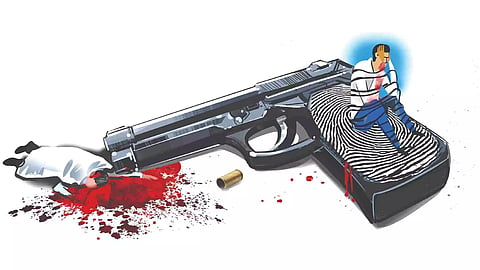

CHENNAI: A trader from Uttar Pradesh wiped the fingerprints off his licensed gun and concocted a story of ‘family troubles’ to the police when his uncle was found dead with bullet wounds in his room at a mansion in Sowcarpet.
Even the initial police records had registered the elderly man’s death as ‘shot by himself’. But, the suspect did not account for the absence of gunshot residue on the dead man, which proved that the deceased could not have fatally shot himself.
It was not even a month since his arrival to Chennai from Mathura, Uttar Pradesh. He had just set up shop in Sowcarpet selling decorative jewellery for Hindu deities.
On the evening of August 1, 2011, Ashish Sharma, then a 25-year-old, visited his uncle, Sudhir Kumar Sharma (52) at his home and both left together to Ashish’s room. Close to midnight, the Elephant Gate Police were alerted about a dead man with bullet wounds.
Ashish claimed that his uncle had gotten drunk that evening and was upset that his son had married outside the community. He alleged that the victim was worried that his daughter would follow suit and thereby, stain the family’s honour.
The Elephant Gate Police too had initially registered a case under Section 174 (suspicious death) before they got credible evidence that Sudhir could not have fatally shot himself. The needle of suspicion fell on Ashish, who, police found out later, had borrowed Rs 5 lakh from the victim’s family.
Sudhir had demanded the money back for expenses for his daughter’s wedding to which Ashish had demanded Rs 5 lakh more and said that he would return the total amount. Police suspected an argument over this and subsequently, arrested Ashish on murder charges.
At trial before the Additional District and Sessions Judge, Georgetown, Ashish maintained that the police tortured him to confess his involvement in his uncle’s death and argued that he had no reason to kill him. “I had a licensed gun which I carry with me for my safety while transporting goods from Mathura for business,” he said.
The prosecution, on its part, submitted that the gun in question was licensed to be used only within the jurisdiction of Mathura district and that Ashish had already committed a crime by bringing it to Tamil Nadu.
Further, the prosecution produced statements from the family members who said that he owed money to the deceased and also saw both leaving together on the day of his death. The security guard at the mansion too, deposed before court that after they had gone to the room, he heard a loud thud and saw Ashish inside the room.
Autopsy reports revealed that the bullet had entered through the skull on the right side and come out of the left side. The Fingerprint bureau officer filed a report stating that there was no fingerprint on the weapon. “The weapon was completely wiped off for prints,” according to the expert.
But, it was the ballistic analysis which ruled out the possibility of suicide. The circumstantial chain of evidence was the final nail against Ashish’s defence. According to the deposition by the forensic surgeon, Dr Santhakumar: “There was no gunshot residue found on the deceased. For such a possibility, the shot must have been made from a distance of at least 40 cm away.”
The Forensic Sciences Laboratory, which did ballistic analysis on the seized gun, submitted that it was a 7.65 mm firearm manufactured by the Indian Ordnance Factories. “We took note of the absence of gunshot residue on the deceased from the post-mortem report. We then tested it by using the gun from various distances and confirmed that there was no gunshot residue when it was used from a distance of 30 inches (76 cm). So, the seized gun was used at least from a distance of 30 inches,” stated P Rajan (then) Deputy Director, TN Forensic Sciences Department, in his deposition.
After perusing the depositions from both sides, Additional District and Sessions Judge G Bhuvaneswari noted that there was enough evidence to place Ashish at the crime scene. She also pointed out the absence of alcohol content in the Viscera analysis, which contradicted the suspect’s version that the deceased was drunk.
“Forensic experts have deposed that usually if a person shoots himself, it’s most likely to be at a point-blank range. In this case, the evidence supports that the shot was not made from a point-blank range and that suicide is ruled out,” the judge pointed out.
The defence counsel argued about the possibility of the deceased shooting himself from a distance of 30 inches as suggested. However, experts stated that it was not practically possible and further pointed out that even if it was considered hypothetically, he could not have wiped off the fingerprints.
“The accused was placed in the crime scene before and after the incident. The submissions by prosecution support the chain of evidence and it’s proved beyond doubt that the accused is guilty as charged,” Judge Bhuvaneswari said, and sentenced Ashish to life in prison.